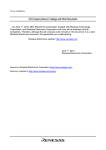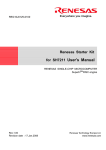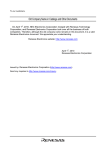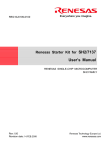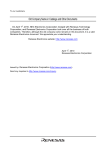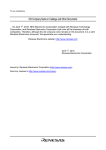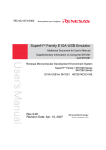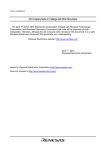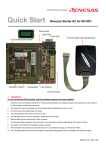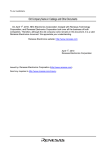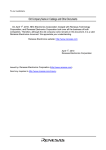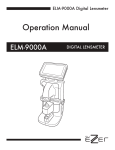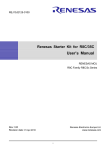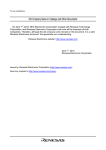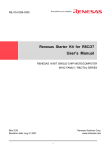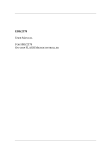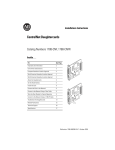Download Renesas Starter Kit for SH7201 User`s Manual
Transcript
To our customers, Old Company Name in Catalogs and Other Documents On April 1st, 2010, NEC Electronics Corporation merged with Renesas Technology Corporation, and Renesas Electronics Corporation took over all the business of both companies. Therefore, although the old company name remains in this document, it is a valid Renesas Electronics document. We appreciate your understanding. Renesas Electronics website: http://www.renesas.com April 1st, 2010 Renesas Electronics Corporation Issued by: Renesas Electronics Corporation (http://www.renesas.com) Send any inquiries to http://www.renesas.com/inquiry. Notice 1. 2. 3. 4. 5. 6. 7. All information included in this document is current as of the date this document is issued. Such information, however, is subject to change without any prior notice. Before purchasing or using any Renesas Electronics products listed herein, please confirm the latest product information with a Renesas Electronics sales office. Also, please pay regular and careful attention to additional and different information to be disclosed by Renesas Electronics such as that disclosed through our website. Renesas Electronics does not assume any liability for infringement of patents, copyrights, or other intellectual property rights of third parties by or arising from the use of Renesas Electronics products or technical information described in this document. No license, express, implied or otherwise, is granted hereby under any patents, copyrights or other intellectual property rights of Renesas Electronics or others. You should not alter, modify, copy, or otherwise misappropriate any Renesas Electronics product, whether in whole or in part. Descriptions of circuits, software and other related information in this document are provided only to illustrate the operation of semiconductor products and application examples. You are fully responsible for the incorporation of these circuits, software, and information in the design of your equipment. Renesas Electronics assumes no responsibility for any losses incurred by you or third parties arising from the use of these circuits, software, or information. When exporting the products or technology described in this document, you should comply with the applicable export control laws and regulations and follow the procedures required by such laws and regulations. You should not use Renesas Electronics products or the technology described in this document for any purpose relating to military applications or use by the military, including but not limited to the development of weapons of mass destruction. Renesas Electronics products and technology may not be used for or incorporated into any products or systems whose manufacture, use, or sale is prohibited under any applicable domestic or foreign laws or regulations. Renesas Electronics has used reasonable care in preparing the information included in this document, but Renesas Electronics does not warrant that such information is error free. Renesas Electronics assumes no liability whatsoever for any damages incurred by you resulting from errors in or omissions from the information included herein. Renesas Electronics products are classified according to the following three quality grades: “Standard”, “High Quality”, and “Specific”. The recommended applications for each Renesas Electronics product depends on the product’s quality grade, as indicated below. You must check the quality grade of each Renesas Electronics product before using it in a particular application. You may not use any Renesas Electronics product for any application categorized as “Specific” without the prior written consent of Renesas Electronics. Further, you may not use any Renesas Electronics product for any application for which it is not intended without the prior written consent of Renesas Electronics. Renesas Electronics shall not be in any way liable for any damages or losses incurred by you or third parties arising from the use of any Renesas Electronics product for an application categorized as “Specific” or for which the product is not intended where you have failed to obtain the prior written consent of Renesas Electronics. The quality grade of each Renesas Electronics product is “Standard” unless otherwise expressly specified in a Renesas Electronics data sheets or data books, etc. “Standard”: 8. 9. 10. 11. 12. Computers; office equipment; communications equipment; test and measurement equipment; audio and visual equipment; home electronic appliances; machine tools; personal electronic equipment; and industrial robots. “High Quality”: Transportation equipment (automobiles, trains, ships, etc.); traffic control systems; anti-disaster systems; anticrime systems; safety equipment; and medical equipment not specifically designed for life support. “Specific”: Aircraft; aerospace equipment; submersible repeaters; nuclear reactor control systems; medical equipment or systems for life support (e.g. artificial life support devices or systems), surgical implantations, or healthcare intervention (e.g. excision, etc.), and any other applications or purposes that pose a direct threat to human life. You should use the Renesas Electronics products described in this document within the range specified by Renesas Electronics, especially with respect to the maximum rating, operating supply voltage range, movement power voltage range, heat radiation characteristics, installation and other product characteristics. Renesas Electronics shall have no liability for malfunctions or damages arising out of the use of Renesas Electronics products beyond such specified ranges. Although Renesas Electronics endeavors to improve the quality and reliability of its products, semiconductor products have specific characteristics such as the occurrence of failure at a certain rate and malfunctions under certain use conditions. Further, Renesas Electronics products are not subject to radiation resistance design. Please be sure to implement safety measures to guard them against the possibility of physical injury, and injury or damage caused by fire in the event of the failure of a Renesas Electronics product, such as safety design for hardware and software including but not limited to redundancy, fire control and malfunction prevention, appropriate treatment for aging degradation or any other appropriate measures. Because the evaluation of microcomputer software alone is very difficult, please evaluate the safety of the final products or system manufactured by you. Please contact a Renesas Electronics sales office for details as to environmental matters such as the environmental compatibility of each Renesas Electronics product. Please use Renesas Electronics products in compliance with all applicable laws and regulations that regulate the inclusion or use of controlled substances, including without limitation, the EU RoHS Directive. Renesas Electronics assumes no liability for damages or losses occurring as a result of your noncompliance with applicable laws and regulations. This document may not be reproduced or duplicated, in any form, in whole or in part, without prior written consent of Renesas Electronics. Please contact a Renesas Electronics sales office if you have any questions regarding the information contained in this document or Renesas Electronics products, or if you have any other inquiries. (Note 1) “Renesas Electronics” as used in this document means Renesas Electronics Corporation and also includes its majorityowned subsidiaries. (Note 2) “Renesas Electronics product(s)” means any product developed or manufactured by or for Renesas Electronics. User’s Manual Renesas Starter Kit for SH7201 User’s Manual RENESAS SINGLE-CHIP MICROCOMPUTER SuperH™ RISC engine Rev.1.00 2006.08 Table of Contents Chapter 1. Preface ..................................................................................................................................................1 Chapter 2. Purpose .................................................................................................................................................2 Chapter 3. Power Supply ........................................................................................................................................3 3.1. Requirements ...............................................................................................................................................3 3.2. Power – Up Behaviour .................................................................................................................................3 Chapter 4. Board Layout .........................................................................................................................................4 4.1. Component Layout .......................................................................................................................................4 4.2. Board Dimensions ........................................................................................................................................5 Chapter 5. Block Diagram .......................................................................................................................................6 Chapter 6. User Circuitry.........................................................................................................................................7 6.1. Switches .......................................................................................................................................................7 6.2. LEDs.............................................................................................................................................................7 6.3. Potentiometer ...............................................................................................................................................7 6.4. Serial port .....................................................................................................................................................8 6.5. LCD Module..................................................................................................................................................8 6.6. Option Links..................................................................................................................................................9 6.7. Oscillator Sources ......................................................................................................................................12 6.8. Reset Circuit ...............................................................................................................................................12 Chapter 7. Modes..................................................................................................................................................13 7.1. FDT Settings...............................................................................................................................................13 7.1.1. User program boot mode.....................................................................................................................14 7.1.2. User Mode ...........................................................................................................................................14 Chapter 8. Programming Methods........................................................................................................................16 8.1. Programming with the E8 ...........................................................................................................................16 8.2. E10A Header ..............................................................................................................................................16 Chapter 9. Headers...............................................................................................................................................17 9.1. Microcontroller Headers .............................................................................................................................17 9.2. Application Headers ...................................................................................................................................21 Chapter 10. Code Development ...........................................................................................................................25 10.1. Overview...................................................................................................................................................25 10.2. Compiler Restrictions ...............................................................................................................................25 10.3. Breakpoint Support...................................................................................................................................25 10.4. Code located in RAM ...............................................................................................................................25 10.5. Code location............................................................................................................................................25 10.6. Memory Map.............................................................................................................................................27 10.7. Baud Rate Setting ....................................................................................................................................28 10.8. Interrupt mask sections ............................................................................................................................28 Chapter 11. Component Placement ......................................................................................................................29 ii Chapter 12. Additional Information........................................................................................................................31 iii Chapter 1. Preface Cautions This document may be, wholly or partially, subject to change without notice. All rights reserved. No one is permitted to reproduce or duplicate, in any form, a part or this entire document without the written permission of Renesas Technology Europe Limited. Trademarks All brand or product names used in this manual are trademarks or registered trademarks of their respective companies or organisations. Copyright © Renesas Technology Europe Ltd. 2006. All rights reserved. © Renesas Technology Corporation. 2006. All rights reserved. © Renesas Solutions Corporation. 2006. All rights reserved. Website: http://www.renesas.com/ Glossary BRR Baud Rate Register ERR Error Rate HMON Embedded Monitor RTE Renesas Technology Europe Ltd. RSK Renesas Starter Kit RSO Renesas Solutions Corp. LCD Liquid Crystal Display CPU Central Processing Unit LED Light Emitting Diode IVT Interrupt Vector Table 1 Chapter 2. Purpose This RSK is an evaluation tool for Renesas microcontrollers. Features include: • Renesas Microcontroller Programming. • User Code Debugging. • User Circuitry such as switches, LEDs and potentiometer(s). • Sample Application. • Sample peripheral device initialisation code. The CPU board contains all the circuitry required for microcontroller operation. This manual describes the technical details of the RSK hardware. The Quick Start Guide and Tutorial Manual provide details of the software installation and debugging environment. 2 Chapter 3. Power Supply 3.1. Requirements This CPU board operates from a 5V power supply. A diode provides reverse polarity protection only if a current limiting power supply is used. All CPU boards are supplied with an E8 debugger. This product is able to power the CPU board with up to 300mA. When the CPU board is connected to another system that system should supply power to the CPU board. All CPU boards have an optional centre positive supply connector using a 2.0mm barrel power jack. Warning The CPU board is neither under not over voltage protected. Use a centre positive supply for this board. 3.2. Power – Up Behaviour When the RSK is purchased the CPU board has the ‘Release’ or stand alone code from the example tutorial code pre-programmed into the Renesas microcontroller. On powering up the board the user LEDs will start to flash. Pressing any switch will cause the LEDs to flash at a rate controlled by the potentiometer. 3 Chapter 4. Board Layout 4.1. Component Layout The following diagram shows top layer component layout of the board. Figure 4-1: Board Layout 4 4.2.Board Dimensions The following diagram gives the board dimensions and connector positions. All through hole connectors are on a common 0.1” grid for easy interfacing. 120.00mm 115.00mm 86.36mm Short Board = 85 mm Corners x4 3mm radius 50.80 mm 43.18 mm 35.56 mm 27.00mm SW 1 SW 2 SW 3 POT JA6 JA2 E10A J4 - Applies to connector with micriocontroller pin1 J1 MC U J3 E8 J2 Serial D9 SKT R E S JA5 JA1 45.00mm Figure 4-2 : Board Dimensions 5 Chapter 5. Block Diagram Figure 5-1 shows the CPU board components and their connectivity. Application Board Headers Power Jack Option Microcontroller Pin Headers Debug Header Option Boot mode pins Boot Circuitry Serial Connector Option Microcontroller RESET pin RESn D-type latch BOOT & BOOTn signals External Flash ROM (4MB) ADC Input IRQ pin IRQ pin IRQ pin External SDRAM (16MB) SW2 Potentiometer SW3 BOOT RES SWITCHES LEDs User: 4 LEDS 1Green, 1Orange, 2Red Figure 5-1: Block Diagram Figure 5-2 shows the connections to the RSK. Figure 5-2 : RSK Connctions 6 Power: Green Boot: Orange Chapter 6. User Circuitry 6.1. Switches There are four switches located on the CPU board. The function of each switch and its connection are shown in Table 6-1. Switch Function RES SW1/BOOT* Microcontroller When pressed; the CPU board microcontroller is reset. RESn, Pin 2 Connects to an IRQ input for user controls. IRQ0, Pin 59 The switch is also used in conjunction with the RES switch to place (Port C, bit 22 ) the device in BOOT mode when not using the E8 debugger. SW2* Connects to an IRQ line for user controls. IRQ1 , Pin 58 (Port C, bit 23) SW3* Connects to an IRQ line for user controls. Also connects to the ADC IRQ2, Pin 57 trigger input. The option is a pair of 0R links. For more details on (Port C, bit 24) option links, please refer to Sec 6.6. Table 6-1: Switch Functions *Refer to schematic for detailed connectivity information. 6.2. LEDs There are six LEDs on the CPU board. The green ‘POWER’ LED lights when the board is powered. The orange BOOT LED indicates the device is in HMON BOOT mode when lit. The four user LEDs are connected to an IO port and will light when their corresponding port pin is set low. Table 6-2, below, shows the LED pin references and their corresponding microcontroller port pin connections. LED Reference (As Microcontroller Port Pin Microcontroller Pin Polarity shown on silkscreen) function Number LED0 Port D bit 13 108 Active Low LED1 Port C bit 13 68 Active Low LED2 Port C bit 20 61 Active Low LED3 Port C bit 21 60 Active Low Table 6-2: LED Port 6.3. Potentiometer A single turn potentiometer is connected to AN0 of the microcontroller. This may be used to vary the input analog voltage value to this pin between AVCC and Ground. 7 6.4. Serial port The microcontroller programming serial port (SCIF5) is connected to the E8 connector. This serial port can optionally be connected to the RS232 transceiver by fitting option resistors and the D connector in position J7. The connections to be fitted are listed in the following table. Description Function Fit for RS232 Remove for E8 Fit for Rs232 Remove for RS232 TxD5 Programming Serial Port R90 R71 R71 R90 RxD5 Programming Serial Port R92 R77 R77 R92 Table 6-3: Serial Options Links The board is designed to accept a straight through RS232 cable. 6.5. LCD Module The LCD module supplied with the RSK can be connected to the connector J6 for use with the tutorial code. Any module that conforms to the pin connections and has a KS0066u compatible controller can be used. The LCD module uses a 4bit interface to reduce the pin allocation. No contrast control is provided; this must be set on the display module. Table 6-4 shows the pin allocation and signal names used on this connector. The module supplied with the CPU board only supports 5V operation. J13 Pin Circuit Net Name Device Pin Circuit Net Name Device Pin Pin 1 Ground - 2 5V Only - 3 No Connection - 4 DLCDRS 70 5 R/W (Wired to Write only) - 6 DLCDE 69 7 No Connection - 8 No connection - 9 No Connection - 10 No connection - 11 DLCD4 121 12 DLCD5 120 13 DLCD6 119 14 DLCD7 118 Table 6-4 LCD Module Connections 8 6.6. Option Links Table 6-5 below describes the function of the option links contained on this CPU board. The default configuration is indicated by BOLD text. Option Link Settings Reference Function Fitted Alternative ( Removed ) R7 FLASH memory Write protects Flash Memory Does not write protect Flash Memory R8 A-D/D-A Connects microcontroller pin 92 to Disconnects microcontroller pin 92 AN6 from AN6 Connects microcontroller pin Disconnects microcontroller pin 92 from 92 to DA0 DA0 Connects microcontroller pin Disconnects microcontroller pin 93 from 93 to DA1 DA1 Connects microcontroller pin 93 to Disconnects microcontroller pin 93 AN7 from AN7 R9 R10 R11 A-D/D-A A-D/D-A A-D/D-A Related To R9 R8 R11 R10 R16 Operating mode Connects MD1 = 0 Does not connect MD1 = 0 R15 R17 Operating mode Connects MD0 = 1 Does not connect MD0 = 1 R18 R18 Operating mode Connects MD0 = 0 Does not connect MD0 = 0 R17 R19 Potentiometer Connects potentiometer to Disconnects potentiometer from R21 microcontroller pin 86 microcontroller pin 86 Enables SDRAM Chip Select Disables SDRAM Chip Select Connects microcontroller pin 86 to Disconnects microcontroller pin 86 AN0 from AN0 Connects microcontroller pin 81 to Disconnects microcontroller pin 81 CS2n from CS2n Enables FLASH Chip Select Disables FLASH Chip Select Connects microcontroller pin Disconnects microcontroller pin 81 from 81 to ADTRGn ADTRGn Enables read from Expansion Disables read from Expansion Connector R20 SDRAM chip select R21 R23 R24 Analog Input Chip Select FLASH chip R19 R25 select R25 R26 ADTRGn Transceiver R23, R59 Connector R28 R29 R30 R31 Motor Control Chip Select Write Signal CAN Connects microcontroller pin 80 to Disconnects microcontroller pin 80 TRISTn from TRISTn Connects microcontroller pin Disconnects microcontroller pin 80 from 80 to CS3n CS3n Connects microcontroller pin 72 to Disconnects microcontroller pin 72 WRn from WRn Connects microcontroller pin Disconnects microcontroller pin 170 from 170 to CAN1_STBn CAN1_STBn 9 R29 R28 R33 R32, R127 R32 R33 Motor Write Signal Connects microcontroller pin 170 Disconnects microcontroller pin 170 to UD from UD Connects microcontroller pin 72 to Disconnects microcontroller pin 72 WR0n from WR0n R31 R30 R34 Operating mode Connects MD_CLK1 = 1 Does not connect MD_CLK1 = 1 R36 R35 Operating mode Connects MD_CLK0 = 1 Does not connect MD_CLK0 = 1 R37 R36 Operating mode Connects MD_CLK1= 0 Does not connect MD_CLK1 = 0 R34 R37 Operating mode Connects MD_CLK0= 0 Does not connect MD_CLK0 = 0 R35 R39 Power supply Connects AVREF to CON_VREF Disconnects AVREF from CON_VREF R72 R44 Oscillator X1 Connects external clock source to Disconnects external clock source R47 microcontroller via CON_EXTAL from microcontroller R45 Oscillator X1 Feedback resistor across X1 No feedback - R46 Oscillator X1 Connects X1 to microcontroller Disconnects X1 from microcontroller - R47 Oscillator X1 Connects external clock source to Disconnects external clock source R44 microcontroller via CON_XTAL from microcontroller Connects external clock source to Disconnects external clock source microcontroller via CON_RTC_X1 from microcontroller R48 Oscillator X2 R50 R49 Oscillator X2 Connects X2 to microcontroller Disconnects X2 from microcontroller R51 R50 Oscillator X2 Connects external clock source to Disconnects external clock source R48 microcontroller via CON_RTC_X2 from microcontroller R51 Oscillator X2 Connects X2 to microcontroller Disconnects X2 from microcontroller R49 R52 Oscillator X2 Feedback resistor across X2 No feedback - R54 Serial port Connects RXD1 to J10 Disconnects RXD1 from J10 R55 R55 Serial port Connects TXD1 to J10 Disconnects TXD1 from J10 R54 R56 Power supply Connects AVCC to Board_VCC Disconnects AVCC from Board_VCC R57, R72 R57 Power supply Connects AVCC to CON_AVCC Disconnects AVCC from CON_AVCC R56 R59 Switches Connects SW3 to ADTRGn Disconnects SW3 from ADTRGn R25, R63 R60 Serial port Connects RS323TX to U9 Disconnects RS232TX from U9 R66, R71, R62 Power supply Connects GROUND to AVSS Disconnects GROUND from AVSS - R63 Switches Connects SW3 to IRQ2n Disconnects SW3 from IRQ2n R59 R64 Serial port Connects TxD1 to U9 Disconnects TxD1 from U9 R81 R66 Serial port Connects TxD0 to U9 Disconnects TxD0 from U9 R60, R71, R90, R92 R68 Power supply Connects UC_VCC to Disconnects UC_VCC from Board_VCC R80, R83 Connects CON_5V to Supply Disconnects CON_5V from Supply R102 regulator input regulator input Connects RS232RX to U9 Disconnects RS323RX from U9 Board_VCC R69 R70 Power Supply Serial port R73, R77, R92 10 R71 Serial port Connects serial port PTTX to Disconnects serial port PTTX from R60, R66, RS232 Serial RS232 Serial R90 R72 Power supply Connects VREF to Board_VCC Disconnects VREF from Board_VCC R56, R39 R73 Serial port Connects RS232 Serial to RxD0 Disconnects RS232 Serial from RxD0 R70, R77, R92 R76 Power supply Connects LCD power to internal Disconnects LCD power from internal 5V R102 Connects serial port PTRX to Disconnects serial port PTRX from R70, R73, RS232 Serial RS232 Serial R92 5V R77 Serial port R78 Serial port Shuts down RS232 transceiver Enables RS232 transceiver R82 R80 Power supply Connects Board_VCC to Disconnects Board_VCC from CON_3V3 R68, R83 CON_3V3 R81 Serial port Connects RxD1 to U9 Disconnects RxD1 from U9 R64 R82 Serial port Enables RS232 transceiver Shuts down RS232 transceiver R78 R83 Power supply Connects 3.3V supply from U8 Disconnects 3.3V supply from U8 R68, R80 Disconnects PTTX from E8_TXD R60, R71 Disconnects PTRX from E8_RXD R70, R77 to Board_VCC R90 E8 connector Connects PTTX to E8_TXD on E8 connector R92 E8 connector Connects PTRX to E8_RXD on E8 connector R102 Power Supply Connects J11 to Board_VCC J11 disconnected from Board_VCC - R104 CAN transceiver Connects CAN0_EN to CAN Disconnects CAN0_EN from CAN R105 0 transceiver 0 transceiver CAN transceiver Connects CRx0 to CAN Disconnects CRx0 from CAN transceiver - 0 transceiver 0 CAN transceiver Connects 5V to CAN Disconnects 5V from CAN transceiver - 0 transceiver 0 VBAT CAN transceiver Connects CTx0 to CAN Disconnects CTx0 from CAN transceiver - 0 transceiver 0 CAN transceiver Connects CAN1_EN to CAN Disconnects CAN1_EN from CAN R110 1 transceiver 1 transceiver CAN transceiver Connects CRx1 to CAN Disconnects CRx1 from CAN transceiver - 1 transceiver 1 CAN transceiver Connects CTx1 to CAN Disconnects CTx1 from CAN transceiver - 1 transceiver 1 CAN transceiver Connects 5V to CAN Disconnects 5V from CAN transceiver - 1 transceiver 1 VBAT CAN transceiver Connects CAN0_ERRn to Disconnects CAN0_ERRn from - 1 microcontroller pin 173 microcontroller pin 173 R106 R107 R108 R109 R111 R112 R118 R120 11 R123 R124 R127 CAN transceiver Connects CAN0_STBn to Disconnects CAN0_STBn from 0 microcontroller pin 166 microcontroller pin 166 CAN transceiver Connects CAN1_ERRn to Disconnects CAN1_ERRn from 0 microcontroller pin 174 microcontroller pin 174 CAN transceiver Connects CAN1_STBn to R31 Disconnects CAN0_STBn from R31 R31 Connects E8_VCC to the Disconnects E8_VCC from the regulator R102 regulator input input Connects BUSYn from FLASH Disconnects BUSYn from FLASH memory chip U3 to microcontroller memory chip U3 from microcontroller IRQ3n IRQ3n - 0 R130 R134 Power supply Interrupt - Table 6-5 Option Links 6.7. Oscillator Sources A crystal oscillator is fitted on the CPU board and used to supply the main clock input to the Renesas microcontroller. Table 6- details the oscillators that are fitted and alternative footprints provided on this CPU board: Component Crystal (X1) Fitted 10MHz (HC49/4H package) Crystal (X2) Fitted 32.768kHz (90SMX package) Table 6-6: Oscillators / Resonators Warning: When replacing the default oscillator with that of another frequency, the debugging monitor will not function unless the following are corrected: • FDT programming kernels supplied are rebuilt for the new frequency • The supplied HMON debugging monitor is updated for baud rate register settings. The user is responsible for code written to support operating speeds other than the default. See the HMON User Manual for details of making the appropriate modifications in the code to accommodate different operating frequencies. 6.8. Reset Circuit The CPU Board includes a simple latch circuit that links the mode selection and reset circuit. This provides an easy method for swapping the device between HMON Boot Mode and User mode. This circuit is not required on customers’ boards as it is intended for providing easy evaluation of the operating modes of the device on the RSK. Please refer to the hardware manual for more information on the requirements of the reset circuit. The reset circuit operates by latching the state of the boot switch (SW1) on pressing the reset button. This control is subsequently used to modify a port pin state to select which code is executed. The reset is held in the active state for a fixed period by a pair of resistors and a capacitor. Please check the reset requirements carefully to ensure the reset circuit on the user’s board meets all the reset timing requirements. 12 Chapter 7.Modes The CPU board supports three operating modes in addition to the SH7201 operating modes. These are, firstly a User mode in which the user’s application code programmed into FLASH memory executes. Secondly a User Program boot mode which allows FDT to re-program the FLASH memory. Thirdly a HMON boot mode which is used to run and debug user code. Since this device does not have on chip FLASH the user Program boot mode allows programming of FLASH memory all bar the first erase block (this block contains the boot code). When using the E8 debugger supplied with the RSK the mode transitions between User Program boot mode and User mode or HMON boot mode are executed automatically. The CPU board provides the capability of changing between User mode and HMON Boot modes using a latch circuit. This is only to provide a simple boot control on this board when the E8 is in use with HMON. To manually enter HMON boot mode, press and hold the SW1/BOOT. The mode pins are held in their boot states while reset is pressed and released. Release the boot button. The BOOT LED will be illuminated to indicate that the microcontroller is in HMON boot mode. In this mode the E8 can be used to make an HMON connection in HEW. Boot mode selection Port pins used to change boot function Boot function Port C Bit 6 (Pin 77) Port D Bit 14 (Pin 107) 0 0 User program boot mode 0 1 (SCIF5 9600 N,8,1 J12 for E8 connection) 1 0 HMON boot mode (SCIF5 250,000 N,8,1 J12 for E8 connection) 1 1 User mode Table 7.1-1: Boot Mode Selection 7.1. FDT Settings In the following sections the tables identify the FDT settings required to connect to the board using the E8Direct debugger interface. The E8 Debugger contains the following ‘pull’ resistors. E8 Pin D Resistor Pull Up (100k) Table 7-2: E8 Mode Pin Drives 13 7.1.1.User program boot mode The boot mode settings for this CPU board are shown in Table 7-3 below: LSI State after Reset FDT Settings End D User program boot Mode 0 Table 7-3: Mode pin settings The following picture shows these settings made in the E8Direct configuration dialog from HEW. Figure 7-1: Boot Mode FDT configuration 7.1.2. User Mode For the device to enter User Mode, reset must be held active while the microcontroller mode pins are held in states specified for User Mode operation. 100K pull up and pull down resistors are used to set the pin states during reset. LSI State after Reset FDT Settings End D User Mode 1 Table 7-1: Mode pin settings 14 Figure 7-2: User mode FDT configuration 15 Chapter 8. Programming Methods All but the first erase block of the Flash device can be programmed when the device is in User program boot mode. Once in this mode, the boot-loader program attempts an FDT connection with a host (for example a PC) through SCIF5 (J12) at 9600 N,8,1 with no flow control. On establishing a connection with the microcontroller, the host may then transmit program data to the microcontroller via the appropriate programming port. Table 8-1 below shows the programming port for this Renesas Microcontroller and its associated pins Programming Port Table – Programming port pins and their CPU board signal names SCIF5 TXD5, Pin 79 RXD5, Pin 78 CPU board Signal Name PTTX PTRX Table 8-1: Serial Port Boot Channel 8.1.Programming with the E8 The Flash Development Toolkit (FDT) is supplied to allow programs to be loaded directly on to the board using the E8. The E8 holds pin D low (connected to SCK5, Pin 78) and resets the CPU invoking the User program boot mode described above. This starts the FDT User boot mode programming kernel. For further information see the User Boot sample code and the FDT kernel code. 8.2.E10A Header This device supports an optional E10A debugging interface. The E10A provides additional debugging features including hardware breakpoints and hardware trace capability. (Check with the website at www.renesas.com or your distributor for a full feature list). Modifications to support E10A Debugger J13 Fit Table 8-2: E10A connections 16 Chapter 9. Headers 9.1. Microcontroller Headers Table 9-1 to Table 9-4 show the microcontroller pin headers and their corresponding microcontroller connections. The header pins connect directly to the microcontroller pin unless otherwise stated. * marks pins where a the link to the microcontroller pin is open circuit due to unfitted link (link ID in brackets) J1 Pin Circuit Net Name Device Pin Pin Circuit Net Name Device Pin 1 GND - 23 A(5) 23 2 RESn 2 24 A(6) 24 3 UC_VCC - 25 A(7) 25 4 NMI 4 26 A(8) 26 5 GND - 27 A(9) 27 6 CON_RTC_X1* 7 28 A(10) 28 7 CON_RTC_X2* 6 29 A(11) 29 8 GND - 30 A(12) 30 9 CON_XTAL* 9 31 A(13) 31 10 COM_EXTAL* 10 32 A(14) 32 11 GND - 33 A(15) 33 12 CKIO* 12 34 A(16) 34 13 UC_VCC - 35 A(17) 35 14 MD_CLK0 14 36 A(18) 36 15 MD_CLK1 15 37 A(19) 37 16 GND - 38 GND - 17 A(0) 17 39 A(20) 39 18 UC_VCC - 40 UC_VCC - 19 A(1) 19 41 A(21) 41 20 A(2) 20 42 A(22) 42 21 A(3) 21 43 A(23) 43 22 A(4) 22 44 Not connected - Table 9-1: J1 microcontroller header 17 J2 Pin Circuit Net Name Device Pin Circuit Net Name Pin Device Pin 1 GND - 23 SDCKE 67 2 DREQ3 46 24 LED1 68 3 DACK3 47 25 DLCDE 69 4 DACT3 48 26 DLCDRS 70 5 DTEND3 49 27 WR1n 71 6 CTx0 50 28 WR0n_WRn 72 7 CRx0 51 29 RDn 73 8 CTx1 52 30 GND - 9 UC_VCC - 31 SDCS0n 75 10 CRx1 54 32 UC_VCC - 11 GND - 33 PTCK 77 12 IRQ3n 56 34 PTRX 78 13 IRQ2n 57 35 PTTX 79 14 IRQ1n 58 36 CS3n_TRISTn 80 15 IRQ0n 59 37 CS2n_ADTRGn 81 16 LED3 60 38 CS1n 82 17 LED2 61 39 CS0n 83 18 DQM1 62 40 AVCC - 19 DQM0 63 41 VREF - 20 SDWEn 64 42 ADPOT_AN0 86 21 SDCASn 65 43 AN1 87 22 SDRASn 66 44 AN2 88 Table 9-2: J2 microcontroller header 18 J3 Pin Circuit Net Name Device Pin Pin Circuit Net Name Device Pin 1 AN3 89 23 TxD1 111 2 AN4 90 24 SCK0 112 3 AN5 91 25 RxD0 113 4 AN6_DA0 92 26 TxD0 114 5 AN7_DA1 93 27 SCK4 115 6 AVSS - 28 RxD4 116 7 IO0 95 29 TxD4 117 8 IO1 96 30 DLCD7 118 9 IO2 97 31 DLCD6 119 10 IO3 98 32 DLCD5 120 11 IO4 99 33 DLCD4 121 12 IO5 100 34 GND - 13 UC_VCC - 35 PIN123 123 14 IO6 102 36 PIN124 124 15 GND - 37 GND - 16 IO7 104 38 UDTRSTn 126 17 SCL2 105 39 UC_VCC - 18 SDA2 106 40 UDTMS 128 19 LED0 108 41 UDTDO 129 20 BOOTn 107 42 UDTDI 130 21 SCK1 109 43 UDTCK 131 22 RxD1 110 44 ASEBRKn 132 Table 9-3: J3 microcontroller header 19 J4 Pin Circuit Net Name Device Pin Pin Circuit Net Name Device Pin 1 ASEMDn 133 23 GND - 2 MD1 134 24 TIOC3A 154 3 MD0 135 25 UC_VCC - 4 WDT_OVFn 136 26 Up 158 5 GND - 27 TIOC3C 159 6 D(0) 138 28 Un 160 7 UC_VCC - 29 Vp 161 8 D(1 140 30 Wp 162 9 D(2) 141 31 Vn 163 10 D(3) 142 32 Wn 164 11 D(4) 143 33 CAN0_EN 165 12 D(5) 144 34 CAN0_STBn 166 13 D(6) 145 35 UC_VCC - 14 D(7) 146 36 CAN1_EN 168 15 D(8) 147 37 GND - 16 D(9) 148 38 UD_CAN1_STBn 170 17 D(10) 149 39 TMO0 171 18 D(11) 150 40 TMRI0 172 19 D(12) 151 41 CAN1_ERRn* 174 20 D(13) 152 42 CAN0_ERRn* 173 21 D(14) 153 43 UC_VCC - 22 D(15) 154 44 MRESn 176 Table 9-4: J4 microcontroller header 20 9.2.Application Headers Table 9-5 and Table 9-6 below show the standard application header connections. Note: Asterisk indications apply to all tables in this section * marks pins where a the link to the microcontroller pin is via a 100R resistor and to BOARD VCC via a 4k7 resistor (100R ID & 4k7 ID) ** marks pins where a the link to the microcontroller pin is open circuit due to unfitted link (link ID in brackets) *** marks pins where a the link to the microcontroller pin is via a fitted 0R link (link ID in brackets) JA1 Pin Header Name CPU board Device Pin Pin Header Name Signal Name CPU board Device Pin Signal Name 1 5V CON_5V - 14 DAC1 DA1 93*** (R10) 2 0V(5V) GROUND - 15 IO_0 IO0 95 3 3V3 CON_3V3 - 16 IO_1 IO1 96 4 0V(3V3) GROUND - 17 IO_2 IO2 97 5 AVcc CON_AVCC 84** (R57) 18 IO_3 IO3 98 6 AVss AVSS 94 19 IO_4 IO4 99 7 AVref CON_VREF 85** (R39) 20 IO_5 IO5 100 8 ADTRG ADTRGn 57** (R59) 21 IO_6 IO6 101 9 AD0 AN0 86** (R21) 22 IO_7 IO7 102 10 AD1 AN1 87 23 IRQ3 IRQ3n 56 11 AD2 AN2 88 24 IIC_EX - - 12 AD3 AN3 89 25 IIC_SDA SDA2 106* (R13 & R4) 13 DAC0 DA0 92*** (R9) 26 IIC_SCL SCL2 105* (R12 & R3) Table 9-5: JA1 Standard Generic Header 21 JA2 Pin Header Name CPU board Device Pin Pin Header Name Signal Name CPU board Device Pin Signal Name 1 RESn RESn 2 14 Un Un 160 2 EXTAL CON_EXTAL 10** (R44) 15 Vp Vp 161 3 NMIn NMI 4 16 Vn Vn 163 4 Vss1 GROUND - 17 Wp Wp 162 5 WDT_OVF WDT_OVFn 136 18 Wn Wn 164 6 SCIaTX TxD0 114 19 TMR0 TMO0 171 7 IRQ0 IRQ0n 59 20 TMR1 TIOC3A 156 8 SCIaRX RXD0 113 21 TRIGa TMRI0 172 9 IRQ1 IRQ1n 58 22 TRIGb TIOC3C 159 10 SCIaCK SCK0 112 23 IRQ2 IRQ2n 57 11 UD UD 170** (R32) 24 TRISTn TRISTn 80** (R28) 12 CTSRTS - - 25 Reserved 13 Up Up 158 26 Reserved Table 9-6: JA2 Standard Generic Header 22 JA3 Pin Header Name CPU board Device Pin Pin Header Name Signal Name CPU board Device Pin Signal Name 1 BA(0) BA(0) - 26 BWRn BWRn - 2 BA(1) BA(1) - 27 BCS1n BCS1n - 3 BA(2) BA(2) - 28 BCS2n BCS2n - 4 BA(3) BA(3) - 29 BD(8) BD(8) - 5 BA(4) BA(4) - 30 BD(9) BD(9) - 6 BA(5) BA(5) - 31 BD(10) BD(10) - 7 BA(6) BA(6) - 32 BD(11) BD(11) - 8 BA(7) BA(7) - 33 BD(12) BD(12) - 9 BA(8) BA(8) - 34 BD(13) BD(13) - 10 BA(9) BA(9) - 35 BD(14) BD(14) - 11 BA(10) BA(10) - 36 BD(15) BD(15) - 12 BA(11) BA(11) - 37 BD(16) BD(16) - 13 BA(12) BA(12) - 38 BD(17) BD(17) - 14 BA(13) BA(13) - 39 BD(18) BD(18) - 15 BA(14) BA(14) - 40 BD(19) BD(19) - 16 BA(15) BA(15) - 41 BD(20) BD(20) - 17 BD(0) BD(0) - 42 BD(21) BD(21) - 18 BD(1) BD(1) - 43 BD(22) BD(22) - 19 BD(2) BD(2) - 44 BSDCLK BSDCLK - 20 BD(3) BD(3) - 45 BCS3n BCS3n - 21 BD(4) BD(4) - 46 Bus Control --- - 22 BD(5) BD(5) - 47 BWR1n BWR1n - 23 BD(6) BD(6) - 48 BWR0n BWR0n - 24 BD(7) BD(7) - 49 Data Bus Strobe --- - 25 BRDn BRDn - 50 Reserved --- - Table 9-7: JA3 Standard Generic Header 23 JA5 Pin Header Name CPU board Device Pin Pin Header Name Signal Name CPU board Device Pin Signal Name 1 AD4 AN4 90 13 Reserved 2 AD5 AN5 91 14 Reserved 3 AD6 AN6 92** (R8) 15 Reserved 4 AD7 AN7 93** (R11) 16 Reserved 5 CAN1TX CTx0 50 17 Reserved 6 CAN1RX CRx0 51 18 Reserved 7 CAN2TX CTx1 52 19 Reserved 8 CAN2TX CTx1 54 20 Reserved 9 Reserved 21 Reserved 10 Reserved 22 Reserved 11 Reserved 23 Reserved 12 Reserved 24 Reserved Table 9-8: JA5 Standard Generic Header JA6 Pin Header Name CPU board Device Pin Pin Header Name Signal Name CPU board Device Pin Signal Name 1 DREQ DREQ3 46 13 Reserved 2 DACK DACK3 47 14 Reserved 3 TEND DTEND3 49 15 Reserved 4 STBYn DACT3 48 16 Reserved 5 RS232TX RS232TX (R60)**** 17 Reserved 6 RS232RX RS232RX (R70)**** 18 Reserved 7 SCIbRX RxD1 110 19 Reserved 8 SCIbTX TxD1 111 20 Reserved 9 SCIcTX TxD4 117 21 Reserved 10 SCIbCX SCK1 109 22 Reserved 11 SCIcCK SCK4 115 23 Reserved 12 SCIcRX RxD4 116 24 Reserved Table 9-9: JA6 Standard Generic Header **** This signal is only connected to the named link, which is not fitted to the board. For details refer to the RSKSH7201 circuit schematics page 5 24 Chapter 10. Code Development 10.1. Overview Note: For all code debugging using Renesas software tools, the CPU board must be connected to a PC USB port via an E8. An E8 is supplied with the RSK product. The HMON embedded monitor code is modified for each specific Renesas microcontroller. HMON enables the High-performance Embedded Workshop (HEW) development environment to establish a connection to the microcontroller and control code execution. Breakpoints may be set in memory to halt code execution at a specific point. Unlike other embedded monitors, HMON is designed to be integrated with the user code. HMON is supplied as a library file and several configuration files. When debugging is no longer required, removing the monitor files and library from the code will leave the user’s code operational. However, because the first block of FLASH memory is used to connect to HMON or FDT (depending on the boot sequence used) the final user code needs to be located specifically for the RSK. See section 10.6 for more detail on the RSK’s memory map. The HMON embedded monitor code must be compiled with user software and downloaded to the CPU board, allowing the users’ code to be debugged within HEW. Due to the continuous process of improvements undertaken by Renesas the user is recommended to review the information provided on the Renesas website at www.renesas.com to check for the latest updates to the Compiler and Debugger manuals. 10.2. Compiler Restrictions The compiler supplied with this RSK is fully functional for a period of 60 days from first use. After the first 60 days of use have expired, the compiler will default to a maximum of 256k code and data. To use the compiler with programs greater than this size you will need to purchase the full tools from your distributor. Warning: The protection software for the compiler will detect changes to the system clock. Changes to the system clock back in time may cause the trial period to expire prematurely. 10.3. Breakpoint Support Limited breakpoints can be located in ROM code. However, code located in RAM may have unlimited breakpoints. To debug with less intrusion you need to purchase the E10A-USB on-chip debugger at additional cost. 10.4. Code located in RAM Double clicking in the breakpoint column in the HEW code window sets the breakpoint. Breakpoints will remain unless they are double clicked to remove them. (See the Tutorial Manual for more information on debugging with the HEW environment.) 10.5. Code location The CPU starts execution from reset vectors located in the first FLASH erase block and runs the boot code. The boot code checks the state of pin 77 (Port C bit 6) for entry to FDT boot programming mode and the state of pin 107 (Port D bit 14) for entry to HMON for debugging. If neither of the pins are asserted LOW the boot code emulates the reset action of the CPU from the addresses shown in the following table. For more information, refer to the tutorial linker section map. 25 Section CRSTVECT Description Reset Vectors (Power on reset and Manual reset) Table 10-1: User Reset Vector Table location 26 Start Size Location (H’bytes) H’ 0001 0000 0x0010 10.6. Memory Map The memory map shown in this section visually describes the locations of program code sections related to HMON, the FDT kernels and the supporting code within the ROM/RAM memory areas of the microcontroller. H'0000 0000 H'0000 BOOT CODE RESET Vector H'0010 Vector table H'0400 H'0001 0000 H'0001 0010 FDT Boot kernel (FDTInit.cde) User Reset Vectors H'0800 FDT User kernel (uGenUSH7201.cde) External FLASH ROM (4M Bytes) ROOT HMON H'03FF FFFF H'0800 0000 External SDRAM (16M Bytes) H'08FF FFFF H'FFF80000 On-Chip RAM = Locked erase block H'FFF8 7FFF Figure 10-1: Memory Map 27 10.7. Baud Rate Setting HMON is initially set to connect at 250000Baud. The value set in the baud rate register for the microcontroller must be altered if the user wishes to change either the serial communication baud rate of the serial port or the operating frequency of the microcontroller. This value is defined in the hmonserialconfiguser.h file, as SCI_CFG_BRR (see the Serial Port section for baud rate register setting values). The project must be re-built and the resulting code downloaded to the microcontroller once the BRR value is changed. Please refer to the HMON User Manual for further information. 10.8. Interrupt mask sections HMON has an interrupt priority of 14. Modules using interrupts should be set to lower than this value (13 or below), so that serial communications and debugging capability is maintained. 28 Chapter 11. Component Placement Figure 11-1: Component Placement (Top Layer) 29 Figure 11-2: Component Placement (Bottom Layer) 30 Chapter 12. Additional Information For details on how to use High-performance Embedded Workshop (HEW), refer to the HEW manual available on the CD or installed in the Manual Navigator. For information about the SH7201 microcontrollers refer to the SH7201 Group Hardware Manual For information about the SH7201 assembly language, refer to the SH Series Programming Manual Online technical support and information is available at: http://www.renesas.com/renesas_starter_kits Technical Contact Details America: [email protected] Europe: [email protected] Japan: [email protected] General information on Renesas Microcontrollers can be found on the Renesas website at: http://www.renesas.com/ 31 Renesas Starter Kit for SH7201 User's Manual Publication Date Rev.1.00 31 August 2006 Published by: Renesas Technology Europe Ltd. Duke’s Meadow, Millboard Road, Bourne End Buckinghamshire SL8 5FH, United Kingdom ©2006 Renesas Technology Europe and Renesas Solutions Corp., All Rights Reserved. Renesas Starter Kit for SH7201 User’s Manual 1753, Shimonumabe, Nakahara-ku, Kawasaki-shi, Kanagawa 211-8668 Japan REG10J0031-0100






































